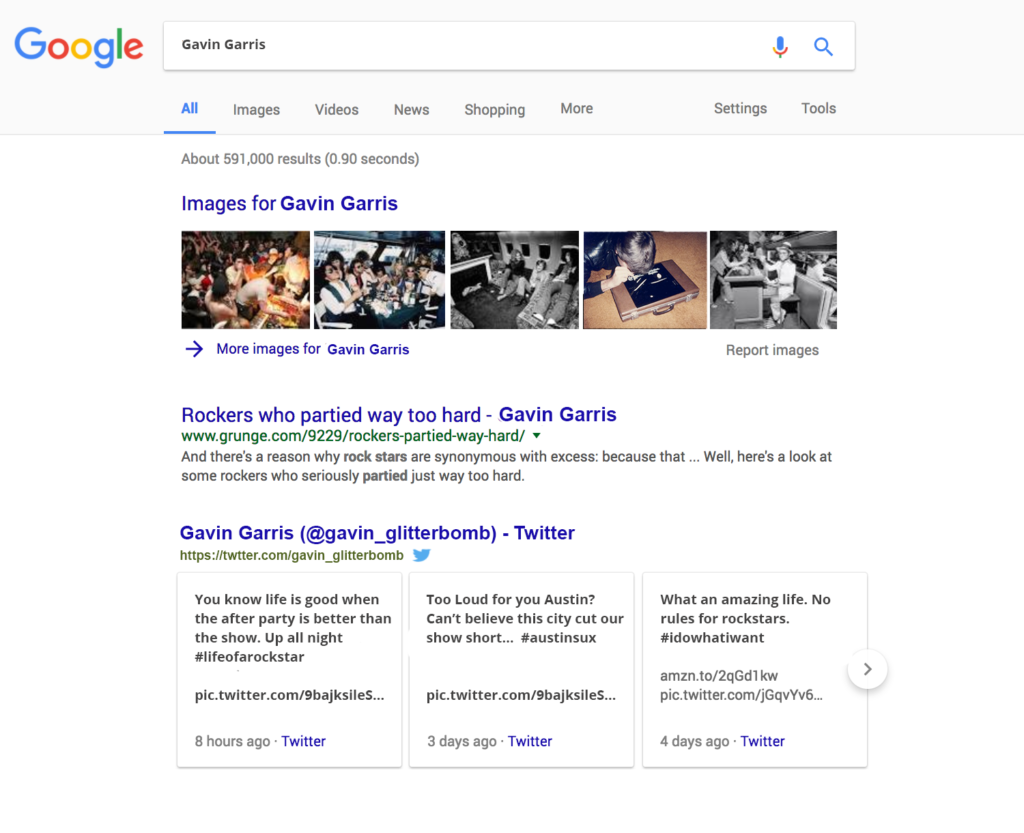The Making of Gavin Garris, Esq.

Last week we introduced you to GAVIN GARRIS. Gavin, frontman of the 80’s glam rock band The Bath Bombs, had retired from a successful music career to settle down with a nice librarian from Louisville. The goal was to attend law school and start a family. But Gavin wasn’t getting anything but flat out rejections. His friend, John, explained that the problem was what happened when admissions professionals googled his name. John offered to help Gavin with reputation management: the process of using SEO to promote desired content about a person or topic while pushing down the content you’d rather forget.
How Google Decided Who Gavin Was
Google and other search engines operate by indexing the web. Google sends its bots and spiders to crawl and then split as links from sites are followed. Depending on a number of factors, Google interprets what people are looking for in searches. What factors?
H1 headings in content.
SEO titles.
Alt tags attached to IMAGES.
Keywords (words used throughout the above and about 1-2.5% times throughout content on a page).
Meta descriptions.
Traffic.
A site’s reputation (The New York Times vs. ReelNewzNow)
Sound familiar? Yeah. It all comes back to SEO. Remember that!
As the spiders crawled the web starting throughout Gavin’s lavish career they built a sense of who Gavin Garris was. It communicated this image by ranking everything from news articles, record reviews, gossip sites, social media and event pages. Gavin used his real and stage name interchangeably and used his real name on his many, many social media posts thus not seeing more banal, but positive results when searching his name. Google compiled a profile of Gavin that represented his hard rock ways. Images include lots of makeup, long sprayed hair and spandex. Articles are about wild parties on the road. Or: things law schools don’t want .
Who Are You?
Have you ever Googled yourself? Of course you have. We all have. For the most part, unless we’re famous or have a huge web presence, our results are pretty basic. Maybe a wedding announcement, the link to your Facebook profile and other social media accounts, race times and a quote from the local paper’s coverage of the garlic festival.
But what about other results? Maybe you were sued by a vengeful neighbor after your teen accidentally ran over his prize rose bush. Or maybe there was that party you threw that got a little out of hand. We all make mistakes, or do things potential employers might frown upon. That was Gavin’s situation.
Do You Need Reputation Management?
When Gavin and John sat down the first thing they did was open an incognito window in their browser and enter Gavin Garris. Sure enough, the results were… interesting.

When someone enters a search they are likely not to scroll and will only look at what is on the screen. This is referred to as “Above The Fold”. In Gavin’s case John counted the image results as one. The 5 above the fold results were as follows:
Rolling Stone Bad Headline
TMZ Bad Headline
Images of Partying
Twitter Profile
Facebook Profile
Reputation Management Can Clean Up Your Image On Google
Scrolling to look at the other six results didn’t yield anything good. Gavin’s neglected website, his Instagram, a news story about his show getting cited for a city noise ordinance, two stories about his love life and rumors of groupies after meeting the librarian and a listicle entitled, “Most Embarrassing Shots of Aging Rockers Who Should Put Their Shirts Back On” from Buzzfeed.
Gavin was crushed. Nothing about high school music and sports and academic achievements. No profiles of his philanthropic work in the Galapagos. “Check the next page,” he pleaded with John.
“The next page doesn’t mean anything.” John looked piteously on his friend and considered moving their meeting to a bar. “First page. Above the fold.”
Gavin found more impressive results on the third or fourth page. “Can we get these to page one?”
“We can.” John knew it was possible. Tune in next time to learn about the many moving parts that go into reputation management or, as it’s also known: reverse SEO.
